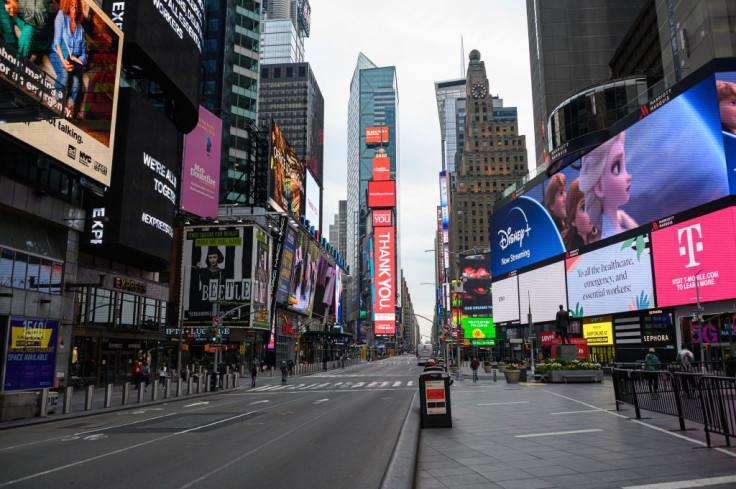Will Retailers Come Back To 'Fashion Hotspot' New York City After The Pandemic?

Once the epicenter of the coronavirus pandemic, New York has flattened the curve -- but at what cost to its economy?
The city has resembled a ghost town during stretches of the pandemic, with a noticeable absence of tourists and businesses shuttered in key districts. Coronavirus cases have declined so significantly that much of the state now has a positivity rate of just 1%. Yet, New York City is losing retailers that had long boasted flagship stores. They've reopened in other states but not New York.
JC Penney closed its Manhattan location permanently, and Neiman Marcus and Kate Spade have shuttered their stores in the area for good. Others such as Victoria’s Secret and Gap have kept their Manhattan stores closed, forgoing rent payments as the coronavirus rages on.
“This is a catalyst moment,” said Anthony V. Lupo, partner and leader in the Fashion and Retail Group at the law firm of Arent Fox LLP.
“The astronomical rent and the landlords' inability to consider alternative rental agreements, such as percentage rent, will drive a lot of existing retail companies out the door.
“I believe that after some time it will create an opportunity for new brands, or old brands that have reconstituted themselves, to reenter New York City in a much more robust manner,” Lupo said in an email to International Business Times, along with other experts for this report.
Retailers that have reopened in New York City have seen their foot traffic dwindle as office workers work remotely and tourists no longer flock to the city. Even more, the streets of New York City are empty as residents who live there are reluctant to go out as the risk of the coronavirus lingers.
“Tourism in New York is dead, office buildings are closed. It’s difficult to survive at this point,” Evi Angelakis, CEO and founder of Golden Key Realty, told IBT. Angelakis' real estate firm focuses on shopping centers, office buildings and development sites.
Many major retailers have filed bankruptcy during the pandemic, including JC Penney, Neiman Marcus, J. Crew and Brooks Brothers as the virus crippled sales as stores were temporarily closed in March. By May, stores began reopening in some areas of the country, but it was too little too late for some retailers that were struggling before the coronavirus hit.
“The lockdown mandated by New York state to contain the COVID-19 pandemic, which closed all nonessential businesses, deprived retail stores of revenue for months, even as these outlets were expected to pay [often expensive] rents,” William Mack, partner at Davidoff Hutcher & Citron LLP, a New York law firm that deals with commercial litigation, told IBT.
“Even now, businesses are still operating with strict limitations, such as mask-wearing and social distancing," he added. "As a result, some retail chains are now finding the economics of maintaining a brick-and-mortar presence in New York City impossible, especially with all the uncertainty about when life will return to some version of normal.”
Complicating the matter are high rent payments compounded by sales that were just too low for some retailers to bear. All that was a “painful blow to what used to be a consumer fashion hotspot,” said Ronen Luzon, founder and CEO at MySizeID, an apparel sizing app.
“Following the shutdown, it’s clear that the economic damage for retailers with a New York ZIP code have been dealt a much tougher hand than those outside the market,” Luzon said.
“Many retailers are choosing to reopen in other states while flagship locations in Manhattan remain closed.
“With many shoppers still nervous about returning to physical retail locations, brands are realizing there is more return on investment by focusing on strengthening their e-commerce operations rather than paying rent prices in the city.”
The shift to e-commerce has been a focus for many retail brands as consumers avoid brick-and-mortar stores during the pandemic. Retailers that had a strong e-commerce platform have fared better than those that didn’t as consumers gravitate toward cyber-shopping amid stay-at-home orders that forced both retailers and customers to get creative.
“Landlords will need to fill these store vacancies, and they will fill them with whatever businesses can pay the rents, or move toward sharing in the profits from the store, as we see some landlords doing,” said Paul Magel, president of Business Applications at Computer Generated Solutions.
“As traditional shopping storefronts change over to new destination spots, we will see traditional shopping areas become something completely different,” Magel continued. “We will see new uses for the space – changing the landscape to new destination spots.”
But the question remains whether New York City can weather the coronavirus and bring back its bustling retail economy. Rob McGovern, CEO at shopper data collection company PreciseTarget, told IBT that as much as “56% of the retail channel capacity is at risk.”
“Clearance sales will become the determining success factor in retail, and brands that can rid themselves of the incredible amount of merchandise sitting in warehouses will come out on top,” he said.
Mack expects the retail market to come back to New York City, but it will take time.
“New York City and its vibrant retail stores will ultimately recover," he said.
"We have experienced difficult times before, from the fiscal crisis in the late 1970s to 9/11 to the financial crisis in 2008.
“Every time, there were skeptics who claimed New York would never reclaim its glory. Despite all the challenges ahead, New York City remains unparalleled as an international center of culture and business, and will once again draw visitors from around the world."
© Copyright IBTimes 2025. All rights reserved.





















